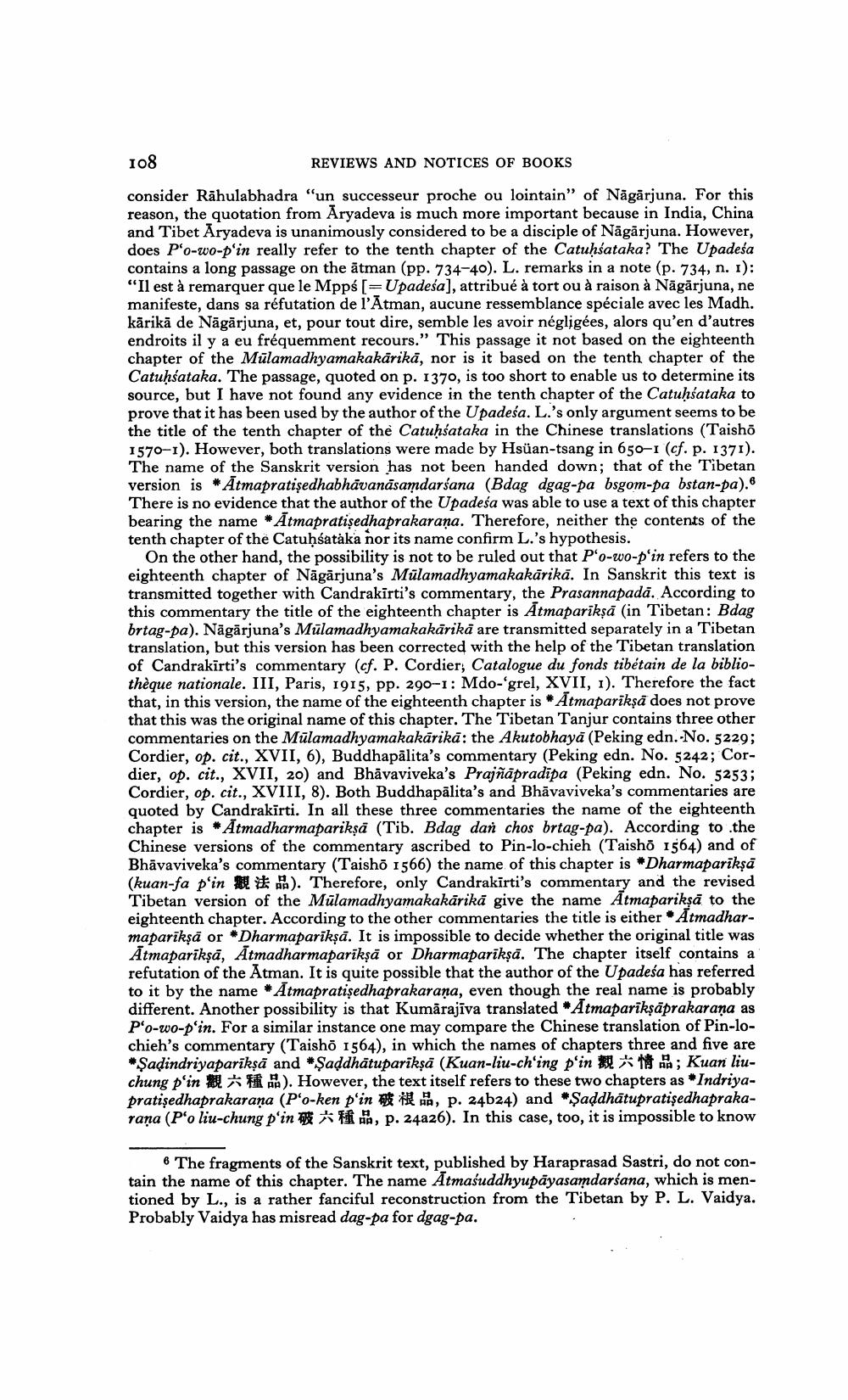________________
108
REVIEWS AND NOTICES OF BOOKS
consider Rāhulabhadra "un successeur proche ou lointain" of Nāgārjuna. For this reason, the quotation from Aryadeva is much more important because in India, China and Tibet Aryadeva is unanimously considered to be a disciple of Nagarjuna. However, does P'o-wo-p'in really refer to the tenth chapter of the Catuḥsataka? The Upadeśa contains a long passage on the atman (pp. 734-40). L. remarks in a note (p. 734, n. I): "Il est à remarquer que le Mpps [=Upadeśa], attribué à tort ou à raison à Nāgārjuna, ne manifeste, dans sa réfutation de l'Atman, aucune ressemblance spéciale avec les Madh. kārikā de Nāgārjuna, et, pour tout dire, semble les avoir négligées, alors qu'en d'autres endroits il y a eu fréquemment recours." This passage it not based on the eighteenth chapter of the Mülamadhyamakakārikā, nor is it based on the tenth chapter of the Catuhsataka. The passage, quoted on p. 1370, is too short to enable us to determine its source, but I have not found any evidence in the tenth chapter of the Catuḥsataka to prove that it has been used by the author of the Upadeśa. L.'s only argument seems to be the title of the tenth chapter of the Catuhsataka in the Chinese translations (Taisho 1570-1). However, both translations were made by Hsüan-tsang in 650-1 (cf. p. 1371). The name of the Sanskrit version has not been handed down; that of the Tibetan version is * Ātmapratişedhabhāvanāsamdarśana (Bdag dgag-pa bsgom-pa bstan-pa).6 There is no evidence that the author of the Upadeśa was able to use a text of this chapter bearing the name * Ātmapratişedhaprakarana. Therefore, neither the contents of the tenth chapter of the Catuhsatáka nor its name confirm Li's hypothesis.
On the other hand, the possibility is not to be ruled out that P'o-wo-p'in refers to the eighteenth chapter of Nāgārjuna's Mülamadhyamakakārikā. In Sanskrit this text is transmitted together with Candrakīrti's commentary, the Prasannapadă. According to this commentary the title of the eighteenth chapter is Atmaparikṣā (in Tibetan: Bdag brtag-pa). Nägarjuna's Mülamadhyamakakärikā are transmitted separately in a Tibetan translation, but this version has been corrected with the help of the Tibetan translation of Candrakirti's commentary (cf. P. Cordier; Catalogue du fonds tibétain de la bibliothèque nationale. III, Paris, 1915, pp. 290-1: Mdo-grel, XVII, 1). Therefore the fact that, in this version, the name of the eighteenth chapter is * Atmapariksā does not prove that this was the original name of this chapter. The Tibetan Tanjur contains three other commentaries on the Mülamadhyamakakārikā: the Akutobhayā (Peking edn. -No. 5229; Cordier, op. cit., XVII, 6), Buddhapalita's commentary (Peking edn. No. 5242; Cordier, op. cit., XVII, 20) and Bhāvaviveka's Prajñāpradipa (Peking edn. No. 5253; Cordier, op. cit., XVIII, 8). Both Buddhapālita's and Bhāvaviveka's commentaries are quoted by Candrakīrti. In all these three commentaries the name of the eighteenth chapter is * Ātmadharmapariksa (Tib. Bdag dan chos brtag-pa). According to the Chinese versions of the commentary ascribed to Pin-lo-chieh (Taisho 1564) and of Bhāvaviveka's commentary (Taisho 1566) the name of this chapter is *Dharmaparikṣā (kuan-fa p'in W ). Therefore, only Candrakirti's commentary and the revised Tibetan version of the Mülamadhyamakakārikā give the name Atmaparikṣā to the eighteenth chapter. According to the other commentaries the title is either * Atmadharmapariksā or "Dharmapariksa. It is impossible to decide whether the original title was Atmapariksā, Atmadharmapariksā or Dharmaparikṣā. The chapter itself contains a refutation of the Atman. It is quite possible that the author of the Upadeśa has referred to it by the name * Ātmapratisedhaprakarana, even though the real name is probably different. Another possibility is that Kumārajīva translated *Atmaparikșaprakarana as P'o-wo-p'in. For a similar instance one may compare the Chinese translation of Pin-lochieh's commentary (Taisho 1564), in which the names of chapters three and five are *Şadindriyapariksa and *Şaddhātupariksa (Kuan-liu-ch'ing p'in
; Kuan liuchung p'in
A). However, the text itself refers to these two chapters as *Indriyapratişedhaprakarana (P'o-ken p'in * , p. 24624) and *Şaddhātupratişedhaprakarana (P'o liu-chung p'in
, p. 24a26). In this case, too, it is impossible to know
6 The fragments of the Sanskrit text, published by Haraprasad Sastri, do not contain the name of this chapter. The name Atmaśuddhyupāyasamdarśana, which is mentioned by L., is a rather fanciful reconstruction from the Tibetan by P. L. Vaidya. Probably Vaidya has misread dag-pa for dgag-pa.




